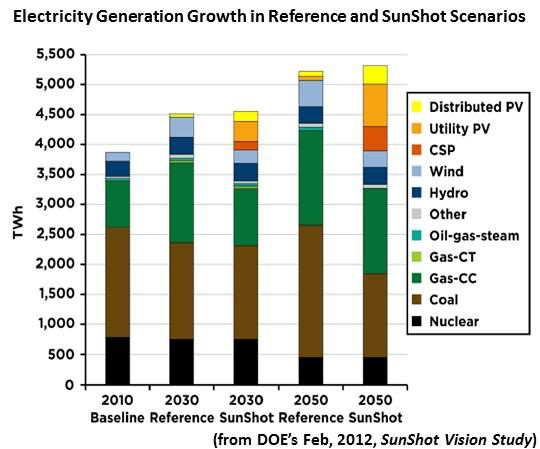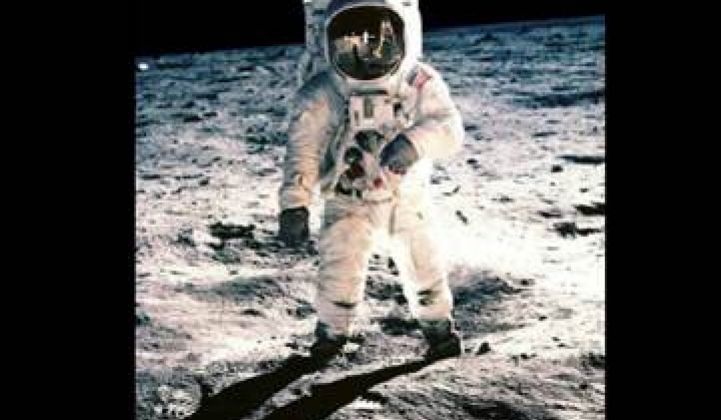The Department of Energy (DOE) SunShot Program has a specific goal: to move the cost of solar-energy-generated electricity to be competitive, without subsidies, with the cost of fossil-fuel-generated electricity by 2020. In service to that, it supports research in every dimension of both photovoltaic (PV) solar and concentrating solar power (CSP) along the entire gamut from basic to applied science. DOE calls SunShot “the Apollo Mission of our time.”
Because things in Washington, D.C. go down more easily when there are numbers attached, DOE Solar Technology Development Manager Joseph Stekli noted that the SunShot program designated an unsubsidized cost of six cents per kilowatt-hour as its target for solar power plants. That translates, according to the DOE, to $3.60 per watt for CSP systems with up to 14 hours of thermal energy storage (TES).
The specific goals for TES are a cost below $15 per kilowatt-hour, a round trip efficiency of 93 percent, and a heat-retaining efficiency of greater than 95 percent.
DOE is also targeting a heat transfer fluid, Stekli added, with a thermal stability of as high as 1,300 degrees C, a freezing below-zero degrees C, a heat capacity twice that of current solar cells and other characteristics similar to currently used molten salts.
Stekli and DOE SunShot PV Team Lead Lidija Sekaric talked about the SunShot program during the Smithers APEX solar summit in San Diego.
Sekaric reported the 2020 target is five cents per kilowatt-hour for PV, which represents approximately $1 per watt (for utility-scale PV, $1.25 for commercial rooftop PV and $1.50 for residential rooftop PV). That would be a 75 percent cost reduction from the cost at the program’s 2011 launch. And, driven by stiff competition from China, Sekaric reported, the Q4 2011 crystalline silicon module price was $1.03 per watt.

SunShot, Sekaric added, is also funding research aimed at bringing down balance-of-system (BOS) costs and rooftop solar “soft costs,” which include finding, financing and contracting with customers, streamlining the red tape associated with permitting, inspection and interconnection, and getting installation and performance monitoring done.
CSP is not coming along as fast, but SunShot-funded research is accruing momentum, Stekli reported. Many more proposals for research came in this year than the program has previously had. “I wish I could tell you more about them, but we haven’t announced them yet,” Stekli said. “Some significant projects will happen that will push CSP toward the six cents per kilowatt-hour goal.”
He did note that for FY 2012, 33 percent of funds went to research labs, 45 percent to industry, and 20 percent to universities. Research into solar power tower technology captured 40 percent of the funds, trough technology got 20 percent, and storage technologies got 30 percent.
There was, Stekli said, a shift of R&D funding between FY 2011 and FY 2012 from trough technology to tower technology, which “represents the state of the technologies.” Trough technology is now seen as essentially proven.
DOE also, Stekli added, funds cutting-edge programs through ARPA-E and loan guarantees. “There are five CSP plants under construction in the U.S. and all have received DOE loan guarantees,” he noted. “Almost $6 billion has been made available for these plants, which will total about 1.3 gigawatts of generating capacity. We’re very excited about these plants and cannot wait to see them come on-line.”

Recovery Act money went largely to ongoing facility improvements at DOE’s National Renewable Energy Laboratory (NREL) and Sandia National Laboratory. The balance went to research.
Asked what the solar industry can expect from DOE in 2013 and beyond, Stekli was politic. “Anyone’s guess is as good as mine,” he said. “The U.S. Senate hasn’t passed a budget in three years and I don’t have any anticipation they will pass a budget next year. We operate under what are called continuing resolutions. Generally, what they do is hold funding flat. It’s an election year. Maybe things change after the election. But we’re moving forward under the assumption our funding will be flat. Beyond next year is unknowable.”



